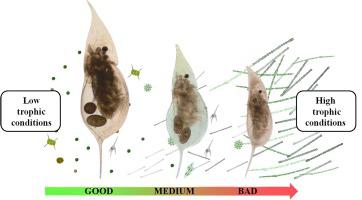Ecological Indicators ( IF 7.0 ) Pub Date : 2020-06-17 , DOI: 10.1016/j.ecolind.2020.106585 Maciej Karpowicz , Łukasz Sługocki , Joanna Kozłowska , Agnieszka Ochocka , Carlos López

|
The main aim of our research was to show that the body size of the planktonic cladoceran Daphnia cucullata can be used as an indicator of the ecological status of lakes. We selected this species because it is one of the most common zooplankton species in Europe and it exhibits a high degree of morphological variability depending on the environmental conditions. Additionally, D. cucullata is almost entirely ignored as a food source by fish unlike other Daphnia species, and often dominates in lakes where fish predation is intense. Therefore, we could minimize the top-down effects (fish pressure) and enhances bottom-up effects (food quality and availability) for this species. We measured the body length, body width, length of head, and length of tail spine of D. cucullata from 104 lakes with different trophic conditions in northern Poland. The results of our study revealed that D. cucullata grows larger in a better resource environment. The body length and width significantly decreased with increasing trophic status. The larger body classes of D. cucullata were absent in highly eutrophic conditions. Therefore, the body size of D. cucullata seems to be a good and simple indicator of the ecological status of lakes. We propose a simple formula for D. cucullata (Body Size Index) based on which we can assess the ecological status of lakes. We believe that our index could be applied to many other planktonic cladocerans.
中文翻译:

水蚤的体型大小可作为温带湖泊生态状况的指标
我们研究的主要目的是表明浮游枝头水蚤Daphnia cucullata的身体大小可以用作湖泊生态状况的指标。我们选择该物种是因为它是欧洲最常见的浮游动物物种之一,并且根据环境条件表现出高度的形态变异性。此外,与其他水蚤种类不同,D。cucullata几乎完全被鱼类作为鱼类的食物来源,并且经常在鱼类捕食力强的湖泊中占主导地位。因此,我们可以最小化该物种的自上而下的影响(鱼压力)并增强自下而上的影响(食物质量和可利用性)。我们测量了人体的身长,身宽,头长和尾脊长来自波兰北部104个营养状况不同的湖泊的D. cucullata。我们的研究结果表明,D。cucullata在更好的资源环境中会变大。身体的长度和宽度随着营养状态的增加而显着降低。在高度富营养化的条件下,D。cucullata的体型更大。因此,D。cucullata的体型似乎是湖泊生态状况的良好且简单的指标。我们提出了一个简单的D. cucullata公式(体型指数),在此基础上我们可以评估湖泊的生态状况。我们相信我们的指数可以应用于许多其他浮游的cladercerans。











































 京公网安备 11010802027423号
京公网安备 11010802027423号